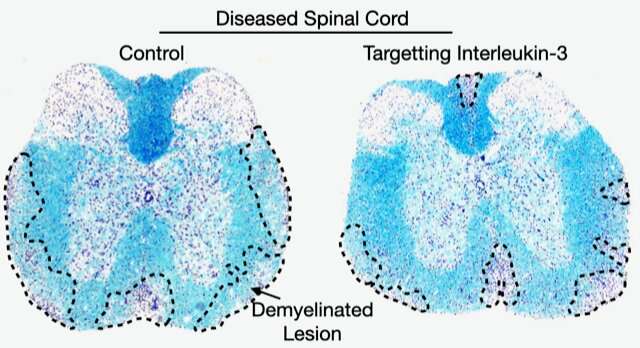This article has been reviewed according to Science X's editorial process and policies. Editors have highlighted the following attributes while ensuring the content's credibility:
fact-checked
peer-reviewed publication
trusted source
proofread
A key biological pathway for multiple sclerosis uncovered

Cross-talk between brain cells and peripheral immune cells can modulate the progression of multiple sclerosis (MS), Mount Sinai researchers have discovered. Their findings reveal a previously unknown way in which the brain and immune system talk to each other and may identify a new therapeutic target for MS and other brain disorders.
In a study published May 8 in the journal Immunity, the team described how the inflammatory protein interleukin-3 (IL-3) coordinates that cellular communication and incites the recruitment of immune cells from the blood to the brain, exacerbating brain inflammation and worsening MS pathology.
"While we've known that brain cells and immune cells are important to multiple sclerosis, the pathways or proteins that act as messengers to mediate communication between these disparate cell populations are poorly understood," says senior author Cameron McAlpine, Ph.D., Assistant Professor of Medicine (Cardiology), and Neuroscience, at the Icahn School of Medicine at Mount Sinai. "We've identified a previously unknown biological pathway in MS involving IL-3 as a mediator of cross-talk between brain and immune cells and an important regulator of brain inflammation."
Multiple sclerosis is a chronic neuroinflammatory disease that affects about a million people in the U.S., with symptoms usually appearing between ages 20 and 40. Characterized by episodes of neurologic disability lasting days or weeks, the disease often progresses over decades and eventually leads to impaired mobility, reduced cognition and, ultimately, paralysis and early death. There is no cure for MS.
Since its discovery decades ago, IL-3 has been associated with multiple disorders. Its link to Alzheimer's disease was identified through groundbreaking research by the same team from the Cardiovascular Research Institute at Mount Sinai; it has also been linked to several inflammatory and autoimmune disorders. But its role in the brain has been vastly understudied.
For their current investigation, Mount Sinai scientists used both human samples and mouse models to explore the pathophysiology of IL-3 in MS. They first measured IL-3 levels in the cerebrospinal fluid of 29 healthy people and 36 MS patients and found that the latter had higher levels of IL-3 in their cerebrospinal fluid, which acts as a watery cushion and a cellular and protein highway for the brain.
Using four unique mouse models, they then learned that resident brain cells known as astrocytes and infiltrating immune cells (T cells) are the major sources of IL-3 in the central nervous system. Moreover, they found that other immune cells known as microglia and infiltrating myeloid cells respond to IL-3 by expressing its receptor, IL3-Ra, and that deleting IL-3 or IL-3Ra significantly reduced immune cell infiltration and inflammation, while noticeably improving the clinical MS symptoms of the mice.
The researchers then returned to human samples and performed single nuclear sequencing of brain cells from six healthy individuals and six MS patients. "We found in the brains of MS patients the appearance of IL-3Ra-expressing myeloid cells, and evidence that these cells are programmed and wired for inflammation and immune cell recruitment, processes that are detrimental in MS," notes lead author Máté Kiss, Ph.D., a postdoctoral fellow from the Cardiovascular Research Institute at Mount Sinai. "This is a critical finding because in MS patients, myeloid cell IL-3Ra expression and IL-3 levels in the cerebrospinal fluid correlate with worse brain inflammation and MS severity."
In identifying a novel mechanism of MS pathogenesis, the research team has implicated IL-3 signaling as a potentially promising new therapeutic target. "Biologics and small molecules targeting IL-3 signaling have been used in cancer therapy," says Dr. McAlpine, "and our work suggests that this pathway could be therapeutically targeted to not only treat MS, but other neuroinflammatory conditions like Alzheimer's disease and dementia as well. However, further work is needed to formally test this."
More information: Cameron McAlpine, Interleukin-3 coordinates glial-peripheral immune crosstalk to incite multiple sclerosis, Immunity (2023). DOI: 10.1016/j.immuni.2023.04.013. www.cell.com/immunity/fulltext … 1074-7613(23)00177-2





















